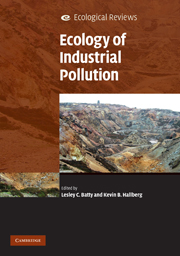Book contents
- Frontmatter
- Contents
- List of contributors
- Preface
- Acknowledgements
- 1 Consequences of living in an industrial world
- 2 Metallophytes: the unique biological resource, its ecology and conservational status in Europe, central Africa and Latin America
- 3 Lichens and industrial pollution
- 4 The impacts of metalliferous drainage on aquatic communities in streams and rivers
- 5 Impacts of emerging contaminants on the environment
- 6 Ecological monitoring and assessment of pollution in rivers
- 7 Detecting ecological effects of pollutants in the aquatic environment
- 8 With the benefit of hindsight: the utility of palaeoecology in wetland condition assessment and identification of restoration targets
- 9 An ecological risk assessment framework for assessing risks from contaminated land in England and Wales
- 10 Diversity and evolution of micro-organisms and pathways for the degradation of environmental contaminants: a case study with the s-triazine herbicides
- 11 The microbial ecology of land and water contaminated with radioactive waste: towards the development of bioremediation options for the nuclear industry
- 12 The microbial ecology of remediating industrially contaminated land: sorting out the bugs in the system
- 13 Ecological recovery in a river polluted to its sources: the River Tame in the English Midlands
- 14 Manchester Ship Canal and Salford Quays: industrial legacy and ecological restoration
- 15 Large-scale mine site restoration of Australian eucalypt forests after bauxite mining: soil management and ecosystem development
- 16 Sustaining industrial activity and ecological quality: the potential role of an ecosystem services approach
- Index
- Plate section
- References
7 - Detecting ecological effects of pollutants in the aquatic environment
Published online by Cambridge University Press: 05 June 2012
- Frontmatter
- Contents
- List of contributors
- Preface
- Acknowledgements
- 1 Consequences of living in an industrial world
- 2 Metallophytes: the unique biological resource, its ecology and conservational status in Europe, central Africa and Latin America
- 3 Lichens and industrial pollution
- 4 The impacts of metalliferous drainage on aquatic communities in streams and rivers
- 5 Impacts of emerging contaminants on the environment
- 6 Ecological monitoring and assessment of pollution in rivers
- 7 Detecting ecological effects of pollutants in the aquatic environment
- 8 With the benefit of hindsight: the utility of palaeoecology in wetland condition assessment and identification of restoration targets
- 9 An ecological risk assessment framework for assessing risks from contaminated land in England and Wales
- 10 Diversity and evolution of micro-organisms and pathways for the degradation of environmental contaminants: a case study with the s-triazine herbicides
- 11 The microbial ecology of land and water contaminated with radioactive waste: towards the development of bioremediation options for the nuclear industry
- 12 The microbial ecology of remediating industrially contaminated land: sorting out the bugs in the system
- 13 Ecological recovery in a river polluted to its sources: the River Tame in the English Midlands
- 14 Manchester Ship Canal and Salford Quays: industrial legacy and ecological restoration
- 15 Large-scale mine site restoration of Australian eucalypt forests after bauxite mining: soil management and ecosystem development
- 16 Sustaining industrial activity and ecological quality: the potential role of an ecosystem services approach
- Index
- Plate section
- References
Summary
Introduction
In the marine environment a widely used definition of pollution is the ‘introduction by man, directly or indirectly, of substances or energy into the marine environment (including estuaries) resulting in deleterious effects such as harm to living resources, hazards to human health, hindrance of marine activities, including fishing, impairing quality for use of sea-water and reduction of amenities’ (GESAMP 1982 – my emphasis). The increasing sophistication of analytical chemical methods means that we can detect contamination by a wide range of chemicals in almost any aquatic environment (see Chapter 5). But the rational regulation of direct contaminant discharges to the environment and the setting of priorities for dealing with contaminants arising from diffuse sources requires us to be able to identify the subset of cases of contamination where deleterious effects are, or may be, occurring. There has been considerable recent improvement in methods for prospective risk assessment – methods that allow an assessment of whether particular concentrations of a substance might cause ecological effects in the field. For example, the development of species sensitivity distributions has given greatly improved information on whether the sensitivity of standard laboratory test organisms reflects the sensitivity of the much wider range of organisms that occur in the field (see, e.g., Maltby et al. 2005), and there is discussion of risk assessment methods elsewhere in this volume (Chapters 5 and 9). However, determining whether an individual substance actually is having deleterious effects on the ecology at any particular location remains a major challenge for ecotoxicology.
- Type
- Chapter
- Information
- Ecology of Industrial Pollution , pp. 147 - 161Publisher: Cambridge University PressPrint publication year: 2010
References
- 1
- Cited by



